Ten astounding German paintings you have to see before you die
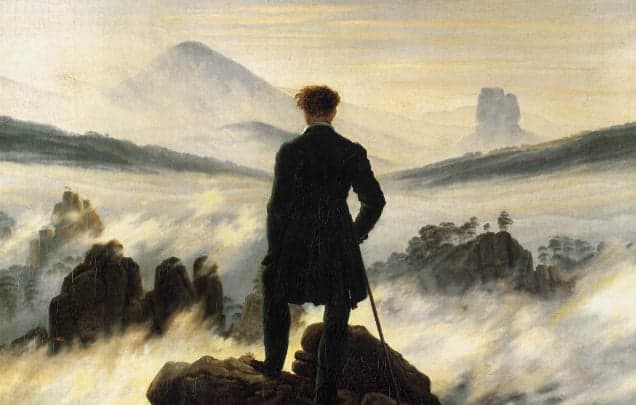
From distorted skulls to abstract strokes, this list compiles ten of German art's most famous and influential pieces.
For all The Local's guides to visiting Germany CLICK HERE
1. Rhinocerus (Rhinoceros) by Albrecht Dürer (1515)
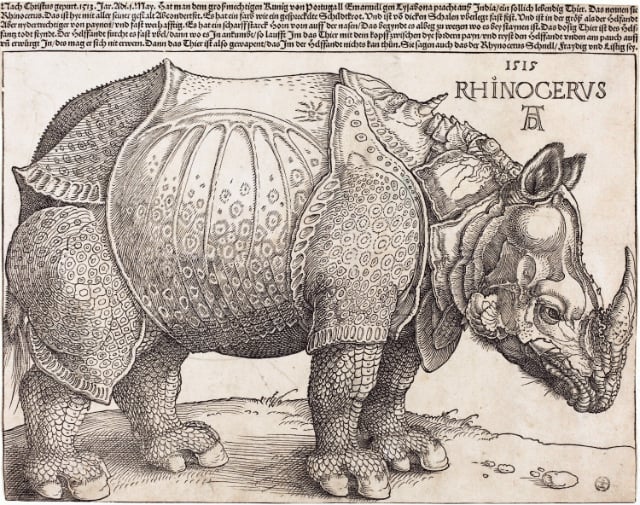 Photo: Wikimedia Commons
Photo: Wikimedia Commons
Well, this first one isn’t strictly a painting, but a woodcut. And that's pretty important, because it meant that it could be printed time and time again, so it was seen by vastly more people than any painting was in the 16th century. It's one of the first "mass produced" pieces of art.
If you look a little closer, you’ll notice it’s not exactly an accurate drawing – there’s even an extra horn on the rhino's back. And that’s because Dürer never actually saw a rhinoceros, but he based it on a brief sketch and letter by an unknown artist.
Many Westerners continued to believe this was a true representation of the animal into the late 18th century. There are original prints of it in both London's British Museum and The Met in New York.
2. Adam and Eve by Lucas Cranach the Elder (1526)
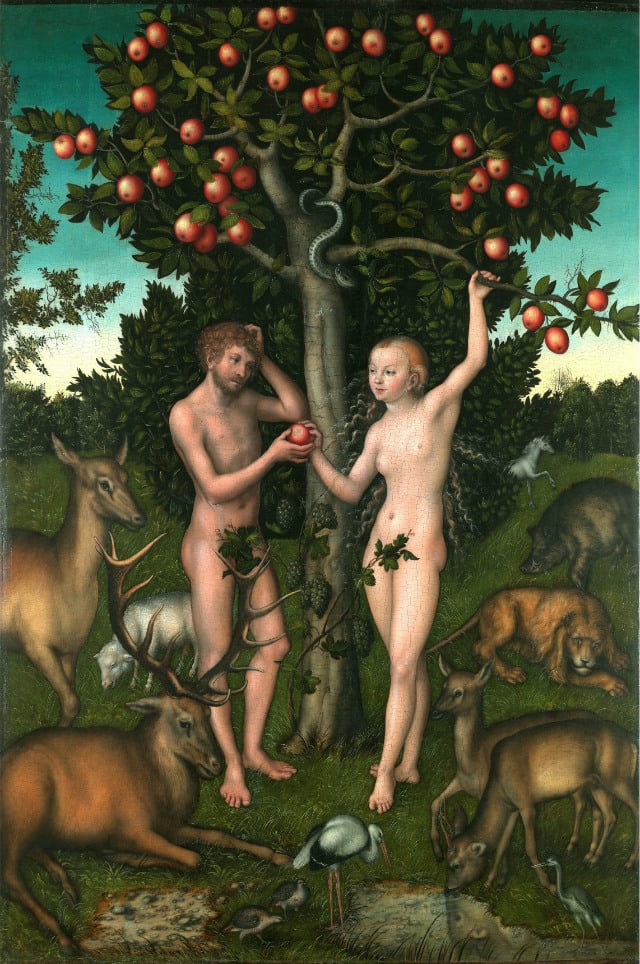 Photo: Wikimedia Commons
Photo: Wikimedia Commons
They may not look it now, but Cranach's Biblical scenes such as this one were pretty raunchy and erotic for his time, especially in comparison with most of the art being painted for churches.
Cranach was also good friends with Martin Luther, famously painting him and many of the other leaders of the Protestant Reformation, which was happening at the time in Germany.
It’s on display at The Courtauld Gallery in London.
3. The Ambassadors by Hans Holbein the Younger (1533)
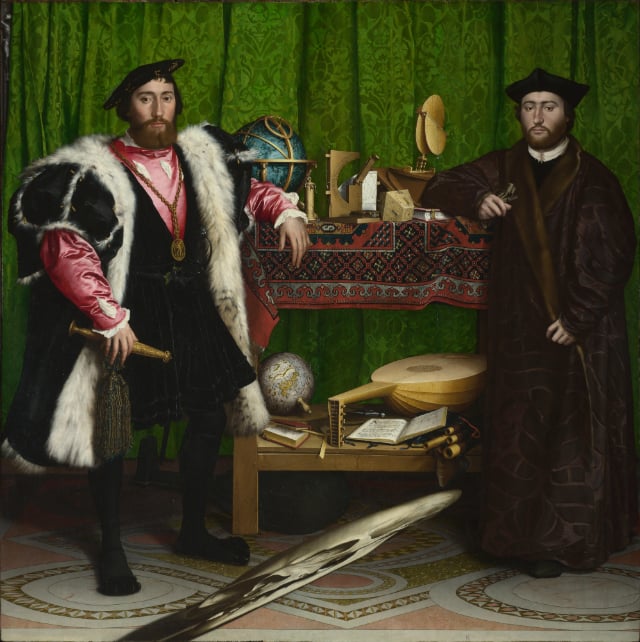 Photo: Wikimedia Commons
Photo: Wikimedia Commons
This painting is unusual as it has a peculiar, elongated shape protruding from the bottom. But when you look closer or from the side, it is actually a distorted skull – a reminder of death – right next to the two splendidly dressed ambassadors.
One of the most famous paintings of the Renaissance, The Ambassadors was actually painted in England. Born in Augsburg, Holbein was German, but also one of the painters that revolutionized art in Britain, bringing the country up to compete with the rest of Europe.
It's one of the most popular paintings in London’s National Gallery collection.
4. Der Wanderer über dem Nebelmeer (Wanderer above the Sea of Fog) by Caspar David Friedrich (1817)
 Photo: Wikimedia Commons
Photo: Wikimedia Commons
We jump nearly 300 years to this next painting – perhaps one of the most recognisable German paintings there is.
Caspar David Friedrich is known for his huge romantic landscapes, and Wanderer above the Sea of Fog is certainly one of his most awe-inspiring scenes. Working at the same time as John Constable and JMW Turner in Britain in the early 19th century, he is perhaps Germany's equivalent landscape master.
Today this painting is often reproduced in magazines, books and adverts, making it one of the most iconic images from that period. It’s housed in the Hamburg Kunsthalle gallery.
5. Das Eisenwalzwerk (Iron Rolling Mill) by Adolph von Menzel (1875)
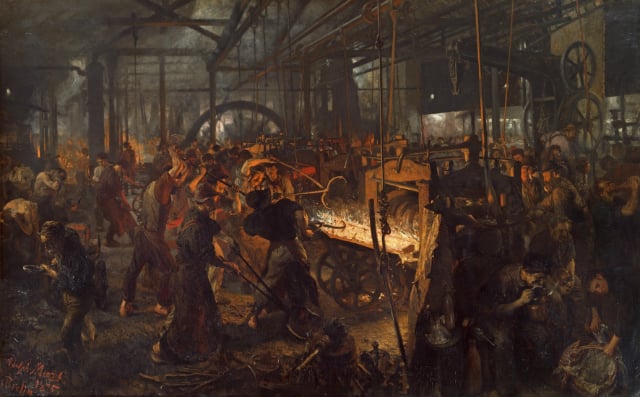 Photo: Wikimedia Commons
Photo: Wikimedia Commons
Whereas the “Wanderer” shows the natural side of Germany, this painting depicts the sweaty scene of a bustling industrial floor.
Menzel was famous for his historical paintings, often depicting grand battle scenes and military processions. But this painting instead depicts the workers at an iron rolling mill, part of the industrial revolution that was happening so rapidly in Germany in the late 19th century.
You can see it in Berlin's Alte Nationalgalerie along with many other of Menzel's more traditional works.
6. Zwei Reiter am Strand (Two Riders on the Beach) by Max Liebermann (1901)
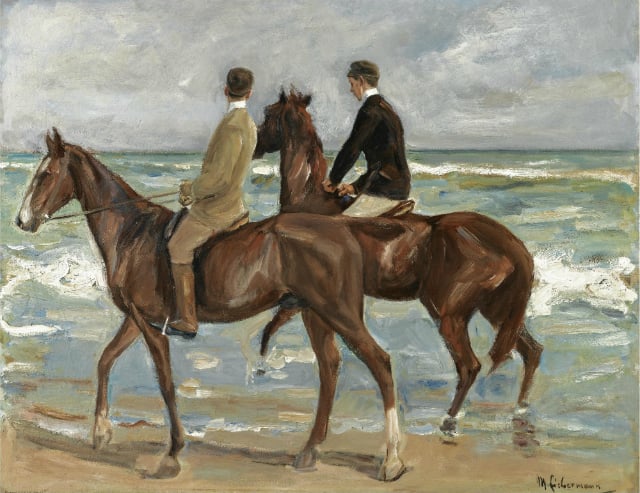 Photo: Wikimedia Commons
Photo: Wikimedia Commons
Max Liebermann is one of the most famous German Impressionist painters, a movement more associated with Claude Monet and Auguste Renoir from France than with German artists.
This is not only a wonderful painting, it also has a fascinating and complicated history. It was originally owned by a Jewish factory owner in the 1930s, but was seized by Nazi authorities after the Kristallnacht pogrom.
As Liebermann was Jewish, it was considered to be “degenerate” art and became part of Nazi art dealer Hildebrand Gurlitt’s collection.
It was seized back by the Allies at the end of the war, before being returned to Gurlitt as he persuaded them he was its rightful owner. Then in 2012 it was famously rediscovered as part of his son Cornelius Gurlitt’s collection that had been stowed away in his Munich flat for decades.
It was one of the few paintings from the horde to be returned to its original owner, who then sold it at Sotheby's to a private collector in 2015 for $2.9 million. Sadly, it is not on public display at the moment, but will hopefully surface for public viewing in the not too distant future.
7. Mutter mit totem Sohn (Mother with Dead Son) by Käthe Kollwitz (1903)
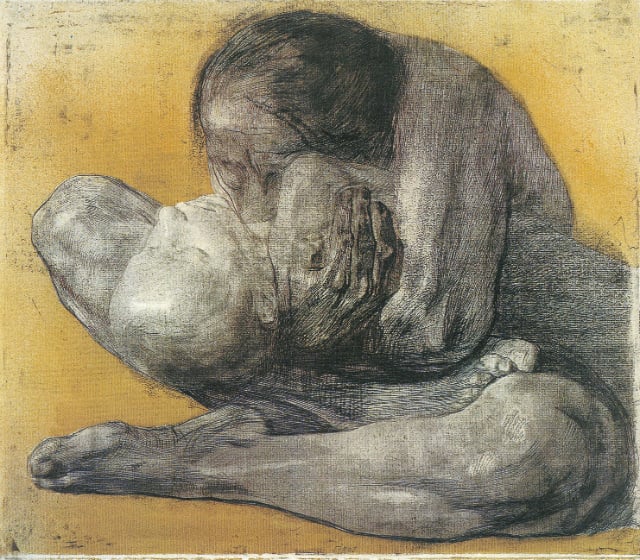 Photo: Wikimedia Commons
Photo: Wikimedia Commons
Käthe Kollwitz is Germany’s most celebrated female artist. Living in the then poverty-stricken Prenzlauer Berg district of Berlin (it's now one of the trendiest areas), she depicted the awful conditions of the poor in the neighbourhood.
Her life was shrouded in misery: she lost one of her sons in the First World War, a grandson in the Second World War, and then died in 1945 shortly before the war’s end.
This drawing of a mother holding her dead son is a moving depiction of pain, and one of her sculptures on the same subject now sits in the Neue Wache, a famous memorial to the victims of war in central Berlin.
8. Potsdamer Platz by Ernst Ludwig Kirchner (1914)
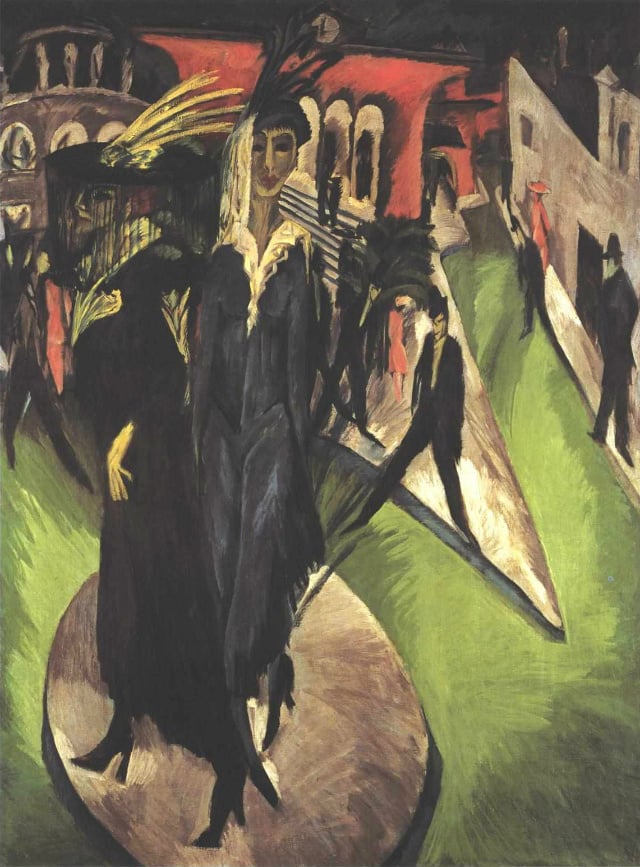
Photo: Wikimedia Commons
Kirchner is one of the most famous artists of the Expressionist movement, which originated in Germany before the outbreak of the First Word War. It was one of the most influential movements of the 20th century, aiming not to depict something accurately but to express emotion.
This painting shows two prostitutes on a roundabout in Potsdamer Platz in Berlin, as potential clients cross the road. Kirchner painted many street scenes like this, showing a very different side to Germany's capital.
It is currently on show in the Kirchner exhibition at the Hamburger Bahnhof gallery in Berlin, and is part of Berlin's Neue Nationalgalerie collection.
9. Abstraktes Bild (599) by Gerhard Richter (1986)
p.p1 {margin: 0.0px 0.0px 0.0px 0.0px; font: 12.0px 'Helvetica Neue'; color: #454545}
span.s1 {text-decoration: underline ; color: #e4af0a}
This abstract piece became world famous when it broke the record for the most expensive painting by a living European artist, selling for a whopping £30.4 million in 2015 at Sotheby's in London.
But Richter is not only known for bringing in the bucks. His abstract and photo-realist artwork is renowned across the world, and he was voted the greatest living artist by a Vanity Fair survey of art experts in 2013.
Others in Richter's series of abstract paintings often appear in temporary exhibitions around the world.
10. Die Ordnung der Engel (The Hierarchy of Angels) by Anselm Kiefer (2000)
Anselm Kiefer is not a conventional artist either, using materials such as straw, ash and clay in his works.
His paintings often deal with Germany’s 20th century past, in particular with the Holocaust. The title of this work suggests something beautiful and traditional, whereas its colours and discarded clothes hint at something different, and much more menacing.
The work has been on display in exhibitions, but still belongs in the artist's private collection.
Comments
See Also
For all The Local's guides to visiting Germany CLICK HERE
1. Rhinocerus (Rhinoceros) by Albrecht Dürer (1515)
 Photo: Wikimedia Commons
Photo: Wikimedia Commons
Well, this first one isn’t strictly a painting, but a woodcut. And that's pretty important, because it meant that it could be printed time and time again, so it was seen by vastly more people than any painting was in the 16th century. It's one of the first "mass produced" pieces of art.
If you look a little closer, you’ll notice it’s not exactly an accurate drawing – there’s even an extra horn on the rhino's back. And that’s because Dürer never actually saw a rhinoceros, but he based it on a brief sketch and letter by an unknown artist.
Many Westerners continued to believe this was a true representation of the animal into the late 18th century. There are original prints of it in both London's British Museum and The Met in New York.
2. Adam and Eve by Lucas Cranach the Elder (1526)
 Photo: Wikimedia Commons
Photo: Wikimedia Commons
They may not look it now, but Cranach's Biblical scenes such as this one were pretty raunchy and erotic for his time, especially in comparison with most of the art being painted for churches.
Cranach was also good friends with Martin Luther, famously painting him and many of the other leaders of the Protestant Reformation, which was happening at the time in Germany.
It’s on display at The Courtauld Gallery in London.
3. The Ambassadors by Hans Holbein the Younger (1533)
 Photo: Wikimedia Commons
Photo: Wikimedia Commons
This painting is unusual as it has a peculiar, elongated shape protruding from the bottom. But when you look closer or from the side, it is actually a distorted skull – a reminder of death – right next to the two splendidly dressed ambassadors.
One of the most famous paintings of the Renaissance, The Ambassadors was actually painted in England. Born in Augsburg, Holbein was German, but also one of the painters that revolutionized art in Britain, bringing the country up to compete with the rest of Europe.
It's one of the most popular paintings in London’s National Gallery collection.
4. Der Wanderer über dem Nebelmeer (Wanderer above the Sea of Fog) by Caspar David Friedrich (1817)
 Photo: Wikimedia Commons
Photo: Wikimedia Commons
We jump nearly 300 years to this next painting – perhaps one of the most recognisable German paintings there is.
Caspar David Friedrich is known for his huge romantic landscapes, and Wanderer above the Sea of Fog is certainly one of his most awe-inspiring scenes. Working at the same time as John Constable and JMW Turner in Britain in the early 19th century, he is perhaps Germany's equivalent landscape master.
Today this painting is often reproduced in magazines, books and adverts, making it one of the most iconic images from that period. It’s housed in the Hamburg Kunsthalle gallery.
5. Das Eisenwalzwerk (Iron Rolling Mill) by Adolph von Menzel (1875)
 Photo: Wikimedia Commons
Photo: Wikimedia Commons
Whereas the “Wanderer” shows the natural side of Germany, this painting depicts the sweaty scene of a bustling industrial floor.
Menzel was famous for his historical paintings, often depicting grand battle scenes and military processions. But this painting instead depicts the workers at an iron rolling mill, part of the industrial revolution that was happening so rapidly in Germany in the late 19th century.
You can see it in Berlin's Alte Nationalgalerie along with many other of Menzel's more traditional works.
6. Zwei Reiter am Strand (Two Riders on the Beach) by Max Liebermann (1901)
 Photo: Wikimedia Commons
Photo: Wikimedia Commons
Max Liebermann is one of the most famous German Impressionist painters, a movement more associated with Claude Monet and Auguste Renoir from France than with German artists.
This is not only a wonderful painting, it also has a fascinating and complicated history. It was originally owned by a Jewish factory owner in the 1930s, but was seized by Nazi authorities after the Kristallnacht pogrom.
As Liebermann was Jewish, it was considered to be “degenerate” art and became part of Nazi art dealer Hildebrand Gurlitt’s collection.
It was seized back by the Allies at the end of the war, before being returned to Gurlitt as he persuaded them he was its rightful owner. Then in 2012 it was famously rediscovered as part of his son Cornelius Gurlitt’s collection that had been stowed away in his Munich flat for decades.
It was one of the few paintings from the horde to be returned to its original owner, who then sold it at Sotheby's to a private collector in 2015 for $2.9 million. Sadly, it is not on public display at the moment, but will hopefully surface for public viewing in the not too distant future.
7. Mutter mit totem Sohn (Mother with Dead Son) by Käthe Kollwitz (1903)
 Photo: Wikimedia Commons
Photo: Wikimedia Commons
Käthe Kollwitz is Germany’s most celebrated female artist. Living in the then poverty-stricken Prenzlauer Berg district of Berlin (it's now one of the trendiest areas), she depicted the awful conditions of the poor in the neighbourhood.
Her life was shrouded in misery: she lost one of her sons in the First World War, a grandson in the Second World War, and then died in 1945 shortly before the war’s end.
This drawing of a mother holding her dead son is a moving depiction of pain, and one of her sculptures on the same subject now sits in the Neue Wache, a famous memorial to the victims of war in central Berlin.
8. Potsdamer Platz by Ernst Ludwig Kirchner (1914)

Photo: Wikimedia Commons
Kirchner is one of the most famous artists of the Expressionist movement, which originated in Germany before the outbreak of the First Word War. It was one of the most influential movements of the 20th century, aiming not to depict something accurately but to express emotion.
This painting shows two prostitutes on a roundabout in Potsdamer Platz in Berlin, as potential clients cross the road. Kirchner painted many street scenes like this, showing a very different side to Germany's capital.
It is currently on show in the Kirchner exhibition at the Hamburger Bahnhof gallery in Berlin, and is part of Berlin's Neue Nationalgalerie collection.
9. Abstraktes Bild (599) by Gerhard Richter (1986)
p.p1 {margin: 0.0px 0.0px 0.0px 0.0px; font: 12.0px 'Helvetica Neue'; color: #454545} span.s1 {text-decoration: underline ; color: #e4af0a}
This abstract piece became world famous when it broke the record for the most expensive painting by a living European artist, selling for a whopping £30.4 million in 2015 at Sotheby's in London.
But Richter is not only known for bringing in the bucks. His abstract and photo-realist artwork is renowned across the world, and he was voted the greatest living artist by a Vanity Fair survey of art experts in 2013.
Others in Richter's series of abstract paintings often appear in temporary exhibitions around the world.
10. Die Ordnung der Engel (The Hierarchy of Angels) by Anselm Kiefer (2000)
Anselm Kiefer is not a conventional artist either, using materials such as straw, ash and clay in his works.
His paintings often deal with Germany’s 20th century past, in particular with the Holocaust. The title of this work suggests something beautiful and traditional, whereas its colours and discarded clothes hint at something different, and much more menacing.
The work has been on display in exhibitions, but still belongs in the artist's private collection.
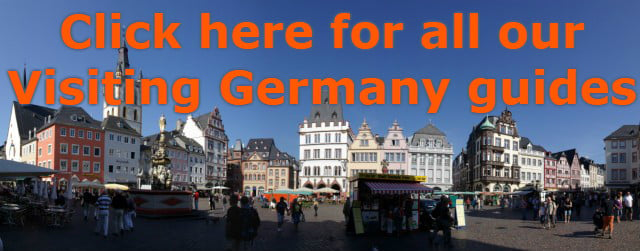
Join the conversation in our comments section below. Share your own views and experience and if you have a question or suggestion for our journalists then email us at [email protected].
Please keep comments civil, constructive and on topic – and make sure to read our terms of use before getting involved.
Please log in here to leave a comment.